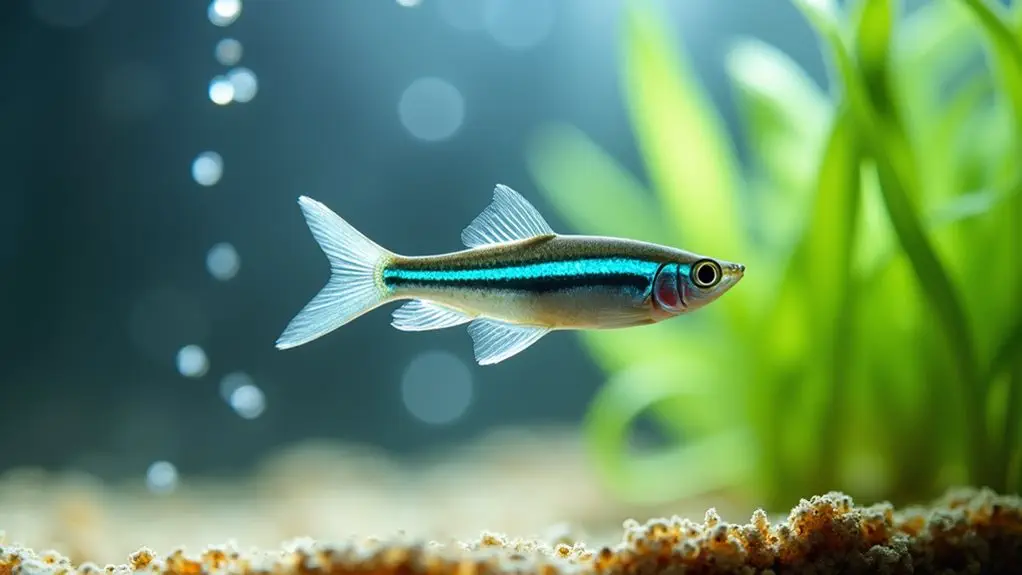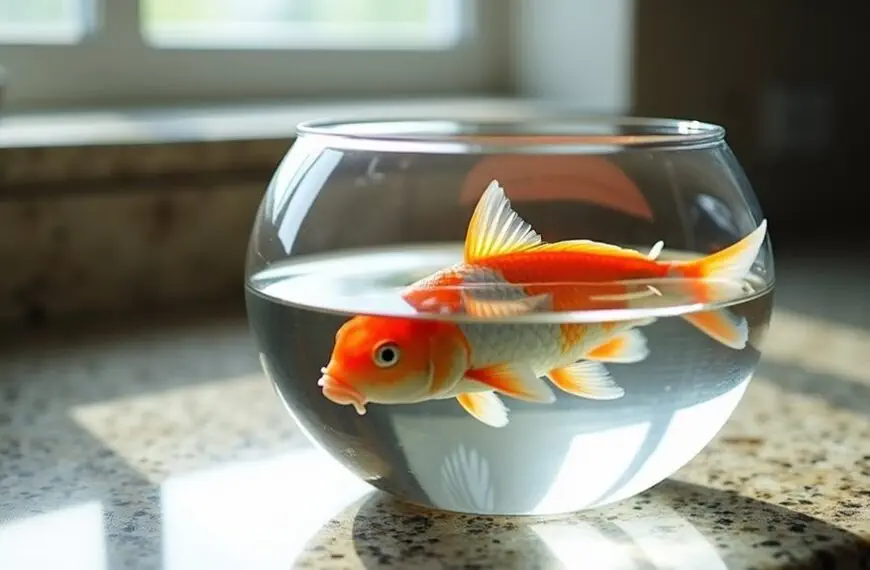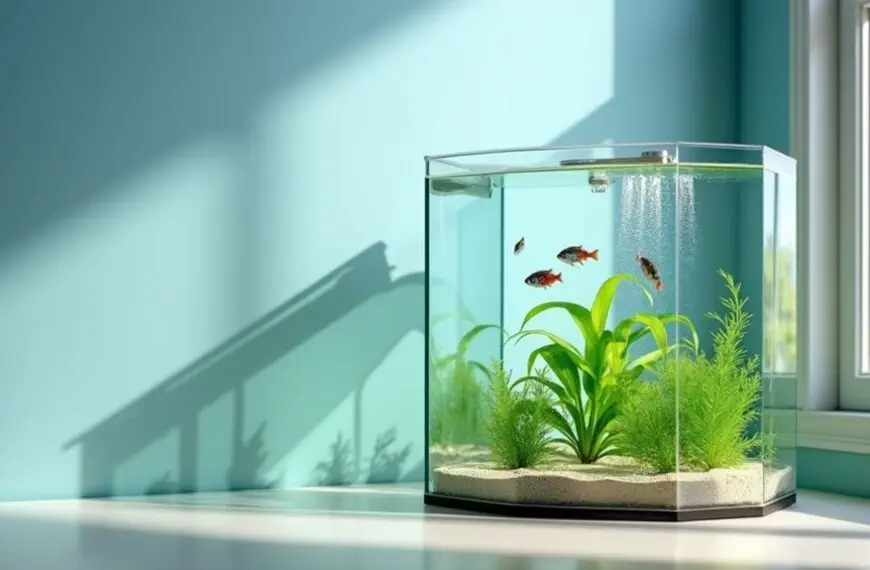You'll want to wait about two weeks after adding fish before performing your first water change, but keep a close eye on those water parameters! If you notice ammonia levels climbing above 0.25 ppm, don't wait – do a 20% water change right away. When it's time for that first change, replace about 20-25% of the water to minimize stress on your new aquatic friends. Remember to use a water conditioner and match the temperature of the new water to your tank's current temperature. There's a whole science to keeping your fish happy and healthy, and proper timing of water changes is just the beginning of their care journey.
Contents
- 1 Understanding New Tank Basics
- 2 Initial Setup Process
- 3 Monitoring Water Parameters
- 4 First Water Change Timing
- 5 Best Practices For New Fish
- 6 Long Term Maintenance Schedule
- 7 Frequently Asked Questions
- 7.1 Can I Use Bottled Spring Water Instead of Tap Water for Changes?
- 7.2 Should I Turn off Aquarium Lights During Water Changes?
- 7.3 How Long Should I Wait Between Adding Different Species of Fish?
- 7.4 Will Adding Live Plants Affect My Water Change Schedule?
- 7.5 Does Feeding Frequency Impact How Often I Need Water Changes?
- 8 Final Thoughts
Understanding New Tank Basics

Success in setting up a new aquarium hinges on understanding the essential first few weeks of tank establishment.
You'll need patience during this vital period, as your tank's ecosystem needs time to develop properly. Think of it as building a tiny underwater city – you can't rush perfection! Bacteria growth occurs primarily on surfaces rather than in the water itself.
Your primary focus should be on establishing beneficial bacteria, which are like the cleaning crew of your aquatic world. These microscopic helpers break down waste and keep your fish healthy through the nitrogen cycle, a process that typically takes 3-6 weeks to complete. Regular water testing helps confirm ideal ammonia levels are established during this time.
During this time, you'll want to test your water frequently for ammonia, nitrite, and nitrate levels – it's like taking your tank's temperature to make sure everything's running smoothly.
Make sure your filter can handle at least triple your tank's volume per hour – it's better to overfilter than underfilter!
While you might be keen to add fish right away, giving your tank about three weeks to stabilize is essential.
This waiting period might seem long, but it's worth it to create a healthy, thriving environment for your future finned friends.
Initial Setup Process
Your aquarium's initial setup requires careful attention to detail and a systematic approach. Creating the perfect tank environment starts with choosing the right location – you'll want a stable, level spot away from temperature fluctuations and close to electrical outlets. Think of it as finding the perfect apartment for your future aquatic friends! The water testing kit will be essential for monitoring your new setup, as regular testing helps ensure optimal water quality parameters.
Once you've nailed the location, it's time for substrate selection and the fun part – decorating! You'll need to rinse your chosen substrate thoroughly (trust me, this step saves you from a cloudy mess later), then add your decorations to create an underwater paradise. The typical initial setup cost ranges around $200 for basic supplies and equipment.
Don't forget to treat your water with conditioner before filling the tank – your future fish will thank you. Using a reliable water conditioner can effectively remove harmful contaminants, promoting a safe environment for your fish.
Next, you'll install all the essential equipment: heater, filter, thermometer, and lighting. Here's a pro tip: arrange your electrical cords in a drip loop to prevent water from running down into outlets.
Once everything's in place, you'll begin the cycling process, which takes patience – about a month of waiting while beneficial bacteria establish themselves. During this time, maintain small water changes and regular testing to confirm your tank's ready for its new inhabitants. Monitoring ammonia and nitrite levels will be crucial during the cycling phase to avoid toxic conditions.
Monitoring Water Parameters
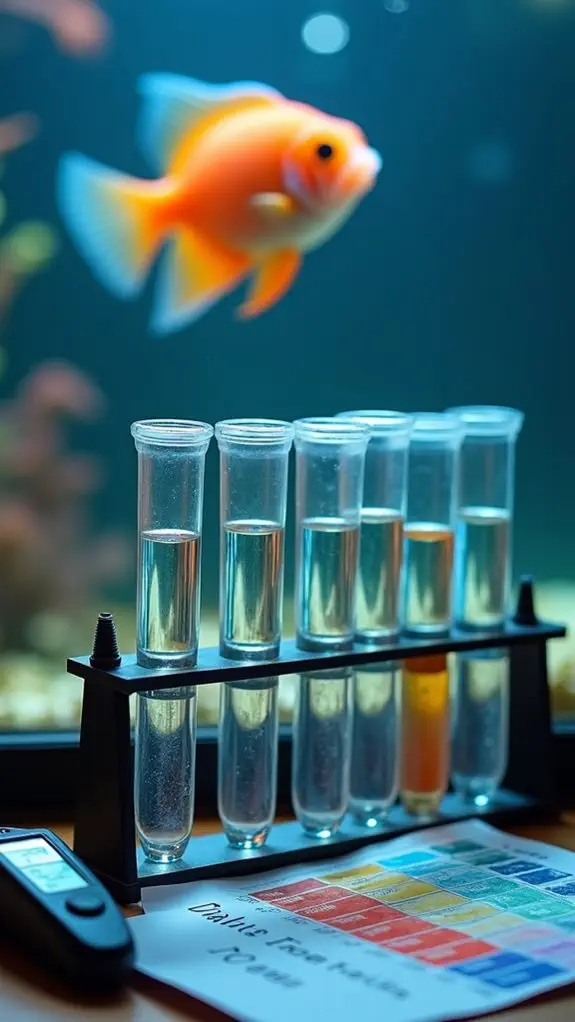
Water parameters are an aquarium's vital signs, telling you exactly how healthy your tank's environment is for its inhabitants.
Think of it like taking your fish's temperature – you'll want to keep a close eye on these numbers to guarantee everyone's swimming happily and healthily.
Your testing frequency will be highest during these first few days after adding fish. You'll need to monitor ammonia, nitrite, and nitrate levels daily, as these are the most essential indicators of water quality. Test these parameters every 2-4 weeks once your tank has fully cycled, ensuring that harmful substances like ammonia and nitrites are kept at safe levels.
Wild-caught species require extra careful monitoring since they can be particularly sensitive to water conditions.
Don't forget to check pH levels too – they're just as important! Use reliable test kits or strips to measure these parameters, and keep a log of your readings to track any changes.
Temperature should stay consistent within your fish's preferred range, typically between 72-78°F. If you've got a saltwater tank, you'll also need to watch those salinity levels carefully.
When you notice any readings outside the normal range, don't panic! Most issues can be resolved with proper adjustments and partial water changes.
First Water Change Timing
You'll want to wait about two weeks after adding fish to your tank before performing your first water change, giving your beneficial bacteria time to establish themselves properly. Regular water changes also help reduce stress-related behaviors in your fish.
During this waiting period, it's crucial to keep a close eye on your water parameters, and if you notice ammonia levels climbing above 0.25 ppm, you'll need to do a 20% water change right away. Using a reliable test kit will ensure you get accurate readings of your tank's parameters.
When you're ready for that first change, start with replacing just 20-25% of the water to avoid stressing your new aquatic friends while still maintaining good water quality. Regular water changes are essential as they help remove harmful toxins that accumulate from fish waste.
Initial Setup Wait Period
Setting up a new aquarium requires patience during the initial weeks, especially when it comes to water changes. You'll need to wait at least two weeks before performing your first water change in a new tank, giving your aquatic environment time to establish itself.
During these first few weeks, you'll want to keep a close eye on your water quality, particularly if you're using bottled bacteria for a quick-start setup. Using filter media from an established tank can significantly speed up the cycling process. Maintaining essential test parameters during this time will help in tracking the tank's progress and preventing issues.
When you notice a bacterial bloom, which looks like cloudy water and typically appears a few days after adding fish, don't panic! It's actually a good sign that your tank's ecosystem is developing. Some hobbyists have found that regular testing triggers positive behaviors in fish, including spawning.
Hold off on water changes during this period unless your test results show concerning levels of ammonia or nitrites. If ammonia readings are above 0 ppm, it's crucial to take corrective measures to protect your fish.
Your tank's size will influence how often you'll need future water changes, with smaller tanks requiring more frequent maintenance.
For a 20-gallon tank, you'll typically want to do a 10% water change weekly.
Remember to let your test kit results guide you – you're aiming for nitrate levels below 15ppm and keeping your pH above 6.5 for a healthy aquarium environment.
Signs To Change Water
Knowing when to perform your first water change requires careful observation of several key indicators. Your aquarium will give you clear signals when it's time to act, and you'll want to pay close attention to both water quality and your fish's behavior.
Watch for signs of fish stress, such as erratic swimming or gasping at the surface, as these behaviors often indicate declining water quality. You'll need to monitor nitrate levels carefully, aiming to keep them between 10-20ppm. When they exceed this range, it's definitely time for a water change. Think of it like changing the air in a stuffy room – your fish will thank you!
Test your water regularly using a reliable test kit, especially in the first few weeks. You're looking for stable pH levels and zero readings for ammonia and nitrites. Regular testing ensures stable living conditions for your fish, which is vital for their health.
If you notice cloudy water clearing up naturally after 2-3 days, that's a good sign your beneficial bacteria are doing their job. Remember, it's better to change water based on these indicators rather than sticking to a rigid schedule. Your aquarium is unique, and learning to read these signs will help you provide the best care for your underwater friends.
Best Practices For New Fish
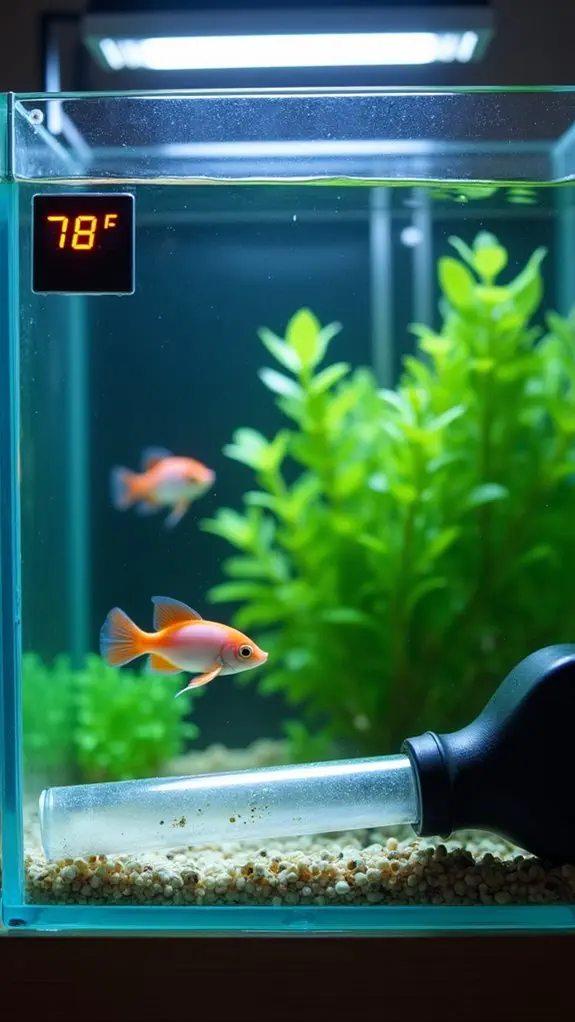
Success with new fish starts with careful preparation and attention to detail. When you're adding new fish to your aquarium, you'll want to focus on fish compatibility and proper acclimation techniques to guarantee your finned friends thrive in their new home.
Start by selecting fish that'll get along with your existing tank inhabitants, and always use a quarantine tank to prevent potential disease spread.
Before introducing your new fish, you'll need to test your water parameters and make sure they're spot-on. The floating bag method is a tried-and-true way to acclimate your fish – just float the bag in your tank for about 20 minutes while gradually adding tank water to it.
Don't dump the bag water into your tank, though; it's like bringing uninvited guests to your party!
For the best results, maintain stable conditions in your tank and watch your new fish closely for any signs of stress or illness. You might be tempted to do immediate water changes, but it's better to wait a few days to avoid overwhelming your new additions. Regularly monitoring water quality parameters is crucial to ensure a healthy environment for your fish.
Long Term Maintenance Schedule
Once your new fish have settled into their home, it's time to establish a solid maintenance routine that'll keep your aquarium thriving. The long term benefits of regular maintenance are undeniable – healthy fish, crystal-clear water, and fewer problems down the road.
Your maintenance frequency should follow a structured schedule that includes daily, weekly, bi-weekly, and monthly tasks. Think of it like taking care of a tiny underwater garden! Here's what you'll need to stay on top of:
- Daily checks of equipment, water levels, and your fish's behavior
- Weekly testing of water parameters and gentle cleaning of tank walls
- Bi-weekly water changes and thorough substrate vacuuming
- Monthly deep cleaning and equipment inspection
Don't worry if this seems overwhelming at first – you'll get into a rhythm that becomes second nature. It's also essential to monitor water quality parameters to ensure a healthy environment for your fish.
Remember to keep a log of your maintenance activities, which helps you track patterns and spot potential issues before they become problems.
Frequently Asked Questions
Can I Use Bottled Spring Water Instead of Tap Water for Changes?
You can use spring water for changes, as it has beneficial minerals, but consider its drawbacks: it's expensive for larger tanks and mineral content varies. Properly treated tap water is often a more practical long-term solution.
Should I Turn off Aquarium Lights During Water Changes?
Yes, you should turn off your aquarium lights during water changes. This reduces fish stress, maintains stable CO2 levels, and helps with water clarity. Keep the light duration short until the water change is complete.
How Long Should I Wait Between Adding Different Species of Fish?
You should wait 2-3 weeks between adding different species to guarantee proper fish compatibility and species integration. This gives your tank's ecosystem time to stabilize and helps reduce stress on all inhabitants.
Will Adding Live Plants Affect My Water Change Schedule?
While live plants can improve your water quality through natural filtration, you'll still need to maintain your regular water change schedule. Monitor parameters closely, as plant growth can affect pH and hardness levels.
Does Feeding Frequency Impact How Often I Need Water Changes?
Yes, your feeding schedule directly impacts water change frequency. When you feed more often, you'll need more frequent water changes due to increased waste production. Less frequent feeding means you can space out water changes longer.
Final Thoughts
You'll want to do your first water change about a week after adding fish to your new tank, assuming your parameters are stable. Remember, there's no need to rush – your new aquatic friends need time to adjust to their environment. Keep testing your water quality daily, and you'll develop a good sense of when changes are needed. With consistent maintenance and a watchful eye, you'll be a confident fish keeper in no time!

